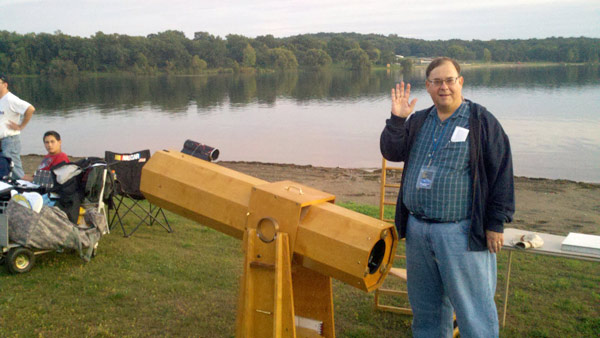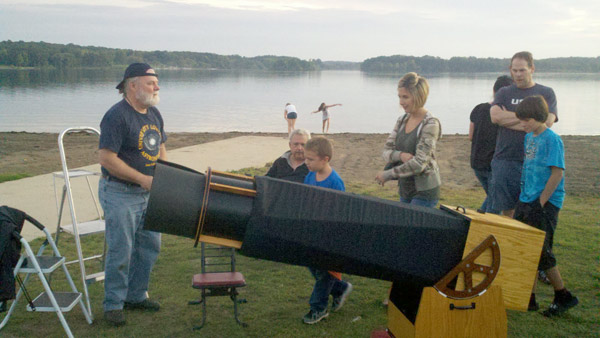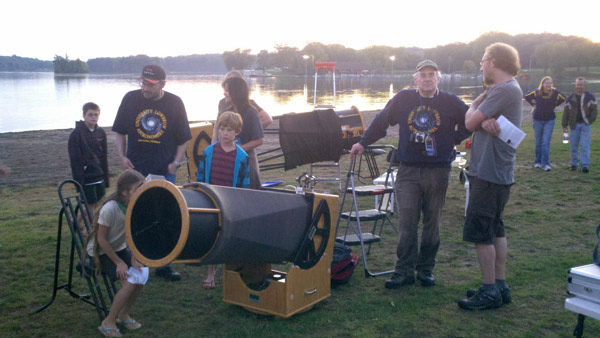

Editor’s Note: I completed the September ‘Reflections’ early the last week of August to get ahead of the Labor Day holiday and my trip to the Okie-Tex Star Party. Putting the issue to bed I realized the Article Bank cupboard was almost bare and put out a call for articles. I got an unexpected reply from Paul asking to put an article he had not yet written into the newsletter I had just finished. He felt a newsletter article might boost member attendance at this year’s event, and while I’m not sure about that I am sure of two things: First, the newsletter is for the members. Most of the time I will not agree that what you have to say will stop the presses, but there are times when a member will be right, which leads me to; Second, Astronomy at the Beach is probably the single most important outreach event we do. Assuming good weather, several thousand people, mostly families with young children, will attend. For many this will be their first look through a telescope and the experience will stay with them a lifetime. So make the time, come out to Kensington Park September 21 & 22 and inspire some young astronomers.—JF

The clear fall nights are fast upon us and along with them a host of star parties to compete for our observing time and energies. If you can only go to one (like that’s ever going to happen) I’d like to recommend that you spend an evening or two doing Astronomy at the Beach at Kensington Metropark on Friday, Sept. 21 and Saturday, Sept. 22, 2012. The Kensington Road (Exit 151 off of I-96) park entrance is the closest expressway off ramp to Maple Beach where the star party is set up, approximately 2-3 miles inside3 the part. The events start with solar observing at 6pm and talk every 30-45 minutes starting at 6:15. Yellow balloons are provided by GLAAC at the pavilion to attach onto “solar ready” scopes. We run public viewing thru telescopes from dusk till midnight or so but need not vacate the park before 2am. This is your opportunity to serve a large crowd. We traditionally have 500-1000 observers on Friday and twice that on Saturday. Almost all of the observers are families or scout groups, but two years ago we had 45 members of a college astronomy class that came well equipped with a list of hundreds of deep sky objects that they needed to observe and journal in order to complete the course requirements. Don’t forget to bring your ladders and step stools for the young folks, and your lesser expensive EP’s If you are leery of stray fingerprints on your optics. Did I mention that your get to meet, talk to, and see a multimedia presentation by Lake Orion’s own Astronaut, Andrew Feustel?
If you go early, say before 6:30 you can drive on the bike path to drop off your equipment, otherwise flag down a park ranger in a golf cart and they will drive you and your equipment from the curb to the set up area in the grass near the Maple Beach Pavilion. The Lowbrows like to set up together, front and center near the pavilion so why not come down and join us? And don’t go to the “other beach” at Kensington because we won’t be there. The rangers traditionally make a point of clearing vehicles form the observing field, but if your telescope is so large that it is trailered, they may look the other way.

We make an effort to keep much of the format of the evening the same from year to year, changing out one talk per year, and bring in a new keynote speaker every year. The changes for 2011 are: Dr. Feustel the astronaut (we can only afford to fly one in one every other year); the youth skit “ The Rescue of Andromeda” has replaced another talk; the 3D movie “Tour of the Constellations” will be part of Astronomy 101; and Prof Walter Kauppila will add a “Fire Tornado” demonstration to our resident wizards’ Kevin Dehne and John Potts “How Cold is Outer Space (AKA Fire and Ice)” lecture demonstration, the source of ooh’s and aah’s that can be heard round the park.
As usual there will be eyepieces, gift certificates, and other astronomy related items for the few GLAAC organizers and the many astronomers who bring scopes each year. The grand prize is a photography package with a camera EP that attaches to a PC. Don’t forget to register for the prize raffle, one ticket per participant, at the Pavilion; ask for George K. GLAAC is nothing more than a loose affiliation of Astronomy clubs that provide volunteers to organize and participate in Astronomy on the Beach and a few other astronomy events throughout the year (Astronomy Day, the Venus Transit, etc.). We are all GLAAC.
There will be limited menu food items (hot dogs, hamburgers, pretzels and drinks) available at the customary high prices, but “Cranks” canteen service from the past has been replaced with a company that is more professional to work with. Alcohol is not permitted, which means that we need to keep our hors d’ourves with flambé presentations and wine and cheese discreet, as usual.
So what were my personal highlights and lowlights at previous GLAACs? The highlights are topped by a three or four year old observer who stood on the top of my observing platform holding a baby bottle and taking a long drink of the moon thru the eyepiece. His dad repeatedly explained to look into the tiny hole and see the moon up close but the child never answered his queries as to whether he actually saw the moon or not while he was observing, he just gave a hush hand signal to his dad. Finally he looked up directly at the moon, back into the EP again and said, “The moon has bubbles”. A true observer, relating wheat he saw back to what he knew. Another highlight was the Mars “closest approach” GLAAC event from 4 years ago. The media grabbed the story and played it long and loud so that between Friday and Saturday night we had 10,000 observers turn out and the lines at each scope never got shorter until 12:45 am. I had set up 20 feet from John’s 24” Dob so as the line wound around the beach many of the folks in his line stopped to view Mars in my scope as well.

The lowlights were a little different in nature, sort of like stories in the vein of Garrison Keillor for “Prairie Home Companion”. One year, I really needed to use the rest room urgently and asked a Lowbrow more known for his intellectual prowess than his short attention span to watch my scope. I returned moments later to find that he had wandered off and was nowhere in sight but two 10 year old boys had turned my wooden dob parallel to the ground and were spinning it around in circles at breakneck speed. Needless to say I needed to collimate my mirror again, once my heart stopped racing.
The other story occurred in one of the first AATB events when my EP was oriented at a 45 degree angle to the tube so that I could easily view objects close to the horizon from a standing position. I was jumping in between every other observer to re-center the moon which was close to setting when an 8-10 year old gal came running to the scope, placed her hands on the wooden tube at the mirror end and mounted the octagonal wooden tube like one would mount a pommel horse in the Olympics. I was peripherally aware of her activities as I centered the moon in the EP, my mind recorded the events as if in slow motion, but I was powerless to stop her as the events played out to their logical conclusion. First I attempted to stand up and yell stop. The next thing was that she weighed down the mirror end and started to slide off and downward. The laws of physics say that the much longer EP end of the optical tube should start to rise up and I can attest to the fact that it must have done so at a high rate of speed because I had the imprint of the EP in the middle of my forehead for a few days afterward. What I actually remember was picking myself off my derrière and that something had knocked the stars loose inside my head. Oh yea, and her folks were grabbing her by the arms and saying things to her like, “What WERE you thinking when you did that”, and “We’ll be going home now” as they dragged her off into the twilight. They also asked if I was all right and hoped no damage had been done, but a lot like a hit and run driver they never left phone number as they hurried off in their embarrassment. Needless to say I adjusted the angle of my EP so that this should not happen again. All in a day’s observing, I guess.
Oh, by the way, in the last year or so a child at a non-GLAAC even did grab the mirror end of the scope and was surprised to find how quickly the scope straightened up. Yea, I still caught the EP in the forehead. Again. But not as hard this time. Perhaps I should wear a bicycle helmet to star parties?
See you all at AATB.
Your Editor’s thanks go to Dave Snyder whose prompt assistance made this supplement possible.
All the photos in this article were taken by John Causland at the 2011 Astronomy at the Beach.